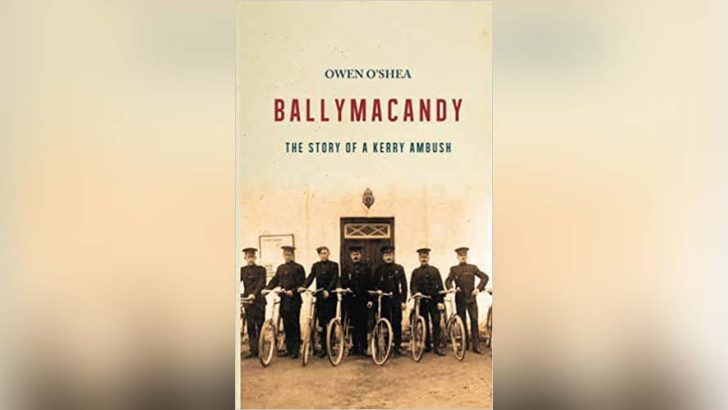Under fire in Ballymacandy: How ‘the Troubles’ came to an Irish village Ballymacandy: The Story of a Kerry Ambush by Owen O’Shea (Irish Academic Press, €14.95/£12.99)
In his latest book Kerry Historian Owen O’Shea provides a dispassionate account of the details surrounding the deadly ambush at Ballymacandy on June 1, 1921 dealing even-handedly with all the actors.
Ballymacandy is just a mile outside the village of Milltown in mid-Kerry, which is situated ten miles from Tralee, the county town. It is a story worth pondering.
A party of 12 policemen were returning to their barracks in Kilorglin after attending the monthly assizes in Tralee. Three were constables of the Royal Irish Constabulary, nine were members of the recently recruited Black and Tans. Led by District Inspector MacCaughey and Sergeant James Collery, they cycled two abreast into the ambush.
The police came under a hail of fire from over 60 members of the Kerry No. 1 and No. 2 Brigades of the IRA who were under the joint-command of Tom O’Connor and Dan Mulvihill.
When firing stopped four of the policemen had been killed and one lay fatally wounded. Seven of the policemen escaped out of the ambush, three of them reaching the safety of their barracks in Kilorglin and four that of their barracks in Tralee. Jerry Myles, one of the attacking party, was seriously wounded and was secreted away on an improvised stretcher to a safe place in the mountains between Glencar and Sneem, where he was cared for by members of Cumann na mBan.
The author records how the residents of Milltown reacted to the incident. On hearing the firing Fr Alexander O’Sullivan, the local curate, rushed to the scene. He was no stranger to gun-fire, having served as a chaplain to the British army in Greece during World War I. He administered the last rites to the dead and the dying. Subsequently he ensured that the bodies of the dead were appropriately cared for and laid-out reverently before the altar in the parish church.
Dr Daniel Sheehan, the local GP, also hastened to the scene and attended the wounded. He ordered an ambulance to take Constable John MacCormack, the most seriously wounded policeman, to Tralee hospital. In the event, this was not possible, as the roads in the area had been made impassable with trenches dug across them, and he became the fifth casualty of the ambush.
The deadly ambush left the residents of the village fearing for the worst. It was a time when the crown forces were carrying out harsh reprisals on the residents of places which were the sites of ambushes.
Anticipating this, Tom O’Connor, the local IRA leader, had a letter delivered to Major Markham Richard Leeson-Marshall, the leading loyalist in the area, that his residence Callinafercy House would be burnt should that be the fate of any of the homes in the village. This prompted him to confer with the military authorities in Ballymullen barracks in Tralee.
Respect
This, it seems, and the respect shown to the bodies of the dead policemen caused the lives and property of the villagers to be spared. There was nothing, however, to spare the grief of the bereaved families of the dead policemen.
Mr O’Shea’s monograph is much more than a Truman Capote style narration of the details of the Ballymacandy ambush. Delving deeply into the witness statements and pension applications in the Bureau of Military History, he provides a comprehensive account of the conduct of the War of Independence in mid-Kerry.
He also describes the membership and activities of Cumann na mBan in the area at that time. And he records how Paddy Cahill was ‘stood down’ by IRA GHQ as OC, Kerry No. 1 Brigade, and replaced by Andy Cooney.
(The book has a number of very informative appendices. Appendix I is a list of participants in the Ballymacandy ambush. Appendix II is a list of members of Milltown District Council of Cumann na mBan in July 1921.)
Owen O’Shea, by the way, from Milltown, Co. Kerry, is a local historian who has written several books exploring aspects of Kerry’s history. An Irish Research Council-funded PhD student at University College Dublin, he is currently researching electioneering and politics in Kerry in the first decade of the Free State, a still controversial topic.



